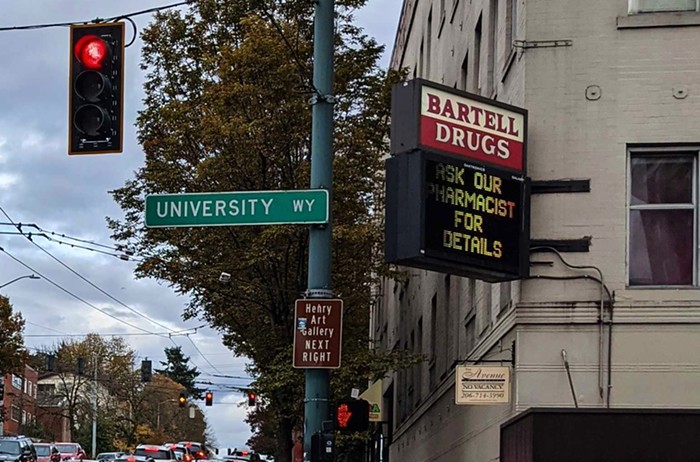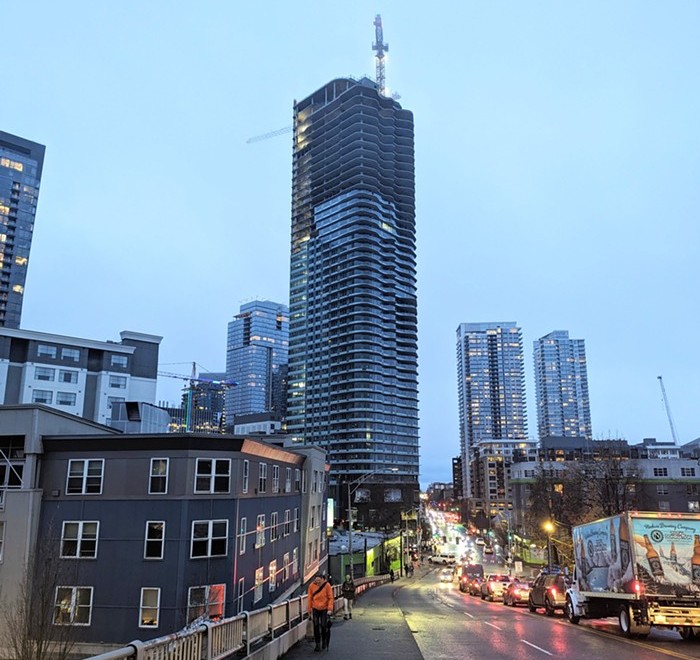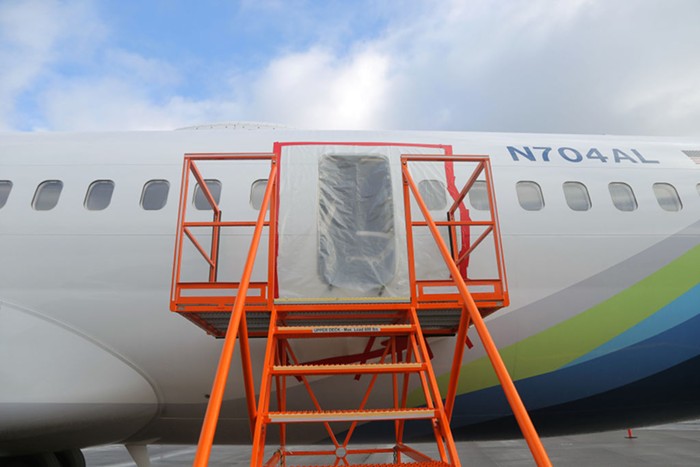
Exactly 10 years ago the University of Washington Press published a very splashy book that examined Seattle as a social/cultural/economic geographic object. Its title: Seattle Geographies.
Its editors, Micheal Brown and Richard Morrill, darkly dedicated the work—which involved a small army of students and scholars (45 in all) at UW's geography department—to our active volcano. They composed its acknowledgments while apparently drinking at the Roanoke Tavern, and filled its first pages with moody images of Seattle: a dusky serial killer taking in the skyline from Gas Works Park, or a crescent moon rising over the 520 floating bridge and the remains of rainless Pacific Northwest day, the shadow of a commercial ship in the bay, and Harbor Island cranes that have just entered evening in a mood that recalls Cecil Taylor's "Enter, Evening (Soft Line Structure)."
From the distance of a decade, it's clear to me that Seattle Geographies captured a city just completing a gentrification process that began in the early 1990s and at that time transitioning to the tech-driven and speculative boom that would spread over much of the second decade of the 21st century. But upon rereading the book this weekend, I found that the chapters concerning Seattle's political, economic, and social geographies are now dated, whereas the chapter concerning its rural geography, isn't. This was a surprise.
Its always an interesting day at Gas Works park :). I learnt something new today - got to see the Red Rebellion at Gas works. #redrebellionbrigade #seattle #gasworkspark #wawx @ShannonODKOMO @CraigHerreraTV #climatecrisis #peacefulprotest pic.twitter.com/OUH15fCnfg
— Shubha Tirumale (@Shubhatirumale) May 23, 2021
The rural world described in Seattle Geographies has certainly changed. It is, for example, more diverse today than it was back then, due to an increase in the Latino population in counties like Adams and Grant. Indeed, the demographic changes in these and other rural areas resembled in many ways those of the suburbs in the 1990s. For example, Adams County, which has a population in the range of Seattle's Georgetown (20,000), was 47% Latino in 2000, 55% in 2008, and is now estimated to be 64%. All counties with a large number of Latinos are following this trend, which mirrors in some ways the one that transformed and diversified suburban America soon after New Urbanism emerged in the mid-1980s and began its march to the city from, of all places, Celebration, Florida.
But the economic structure of rural Seattle examined in the book's still-relevant chapter "Beyond the Dominant Image: Theorizing Rural Difference," has not changed much. Its three depressing components are: The Seattle rural area as playground, the Seattle rural area as dumping ground, and the Seattle rural area as an unseen. Bring these parts together and we have an economy that, when generalized, explains why the US went through four astonishingly stupid years of Trump's presidency.
The researchers in Seattle Geographies locate rural playgrounds...
...mountains, lakes, coastal shores, forests, national parks, and ski resorts. They are easily recognizable for their beauty and wildness. Playgrounds are dominant in the public imaginaries of the Northwest. People want to live in these places because of their leisure-time activities and aesthetics. These areas are experiencing substantial gentrification, as they become the sites of second, third, and even fourth homes of the wealthy and famous.(In another post I will attempt to distinguish playgrounds from gentrification. I'm still of the opinion that they are very different economic processes.)Tourism is an important aspect of any economy, and property values are significantly higher in playgrounds than in other rural areas. Playgrounds may also be locations for businesses primarily serving wealthy or middle class consumers, such as art galleries, boutique clothing and sporting goods stores, gourmet restaurants, and artisanal bakeries.
As for dumping grounds:
These places are former farming areas, ranchlands and/or resource-extraction areas that offer labor, land, and water resources in order to attract prisons, farming factories, and food processing plants and thus bring economic development to rural areas of high unemployment and poverty. Economies of dumping grounds are moving increasingly toward retail and service-sector activities dominated by discount stores such as Wal-Mart and fast food chains such as McDonald's and Burger King. The areas may be near beautiful mountains or rivers, but they lack the spectacular scenery of playgrounds and proximity to large urban areas or well-known national parks. Rural economic restructuring in these areas is signaled by the closure of mines and a downturn in logging activities, leaving rural places starved for jobs and a secure tax base. City and county leaders compete with other rural areas around the country to attract national and transnational agribusiness and manufacturing firms, state and federal prisons, and other forms of business through the lure of cheap land, water, and labor, as well as by offering tax breaks or infrastructural development (such as roads).
And unseen grounds are...
...are the forgotten, invisible, rural places of the Northwest. Examples are Hooper and Warren counties in Montana; areas in northeastern Washington State, and parts of southern Idaho. They are marked by shuttered shops, dying small towns, and out-migration in the wake of the decline in natural resource extraction through logging and mining. These places may face environmental problems of declining water quality or soil fertility as a result of historic forms of resource extraction. They are the marginalized environments of struggling small ranches and low-paid service sector employment, offering little economic opportunity for young families for a sustained quality of life. ...[U]nseen grounds are not destination points for tourists; they are the bypassed spaces in the New West.
There is so much to unpack in each of these categories, but I want to focus the end of this post on the second one, which, unlike the unseen grounds, has as one of its key economic engines the US's huge prison system.
Basically, urban areas have been exporting carceral bodies to its exurbs and rural areas. This development began in the early 1970s at a point that the sociologist Bruce Western described in his 2006 book, Punishment and Inequality in America, as the US's "punitive turn." Here, “[p]rison construction became [more and more] an instrument for regional development as small towns lobbied for construction facilities and resisted prison closure.” Three decades after the putative turn, “over a million black children—9 percent of those under 18—had a father in jail."
Can you see where all of this is going? If not, here it is: The whole All Lives Matter counter-movement to Black Lives Matter has the bulk of its supporters in rural areas. For them, this particular feeling about law enforcers is inextricably mixed with a sense of patriotism that's directly tapped from the state's images and codes of military power.
As Memorial Day approaches, SPD and other law enforcement representatives are visiting the final resting place of 21 law enforcement Officers who died in the line of duty in Spokane County. A rose and a thin blue line flag will be placed at each site. #MemorialDay #Heroes pic.twitter.com/R33zsJtqYJ
— Spokane Police (@SpokanePD) May 27, 2021
The police officer protects, sacrifices, dies on duty, and so on. All of this sounds noble. But in truth it's about meat and potatoes, bringing home the bacon, spreading the butter.
Rural counties are apparently absorbing some of the exodus of cops from the Seattle Police Department. But in reality, a cop moving to rural Seattle makes little or no sense because the bodies needed to keep the prison system running at a level that's viable for a rural economy are not found there. They are in the city and suburbs. If cops are not arresting bodies for export to dumping grounds, then what are they doing with all of their time?

















